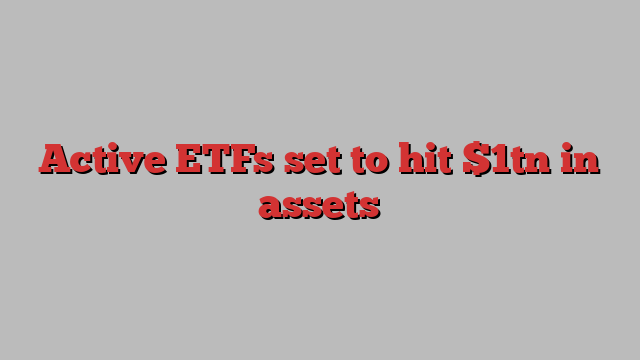
Actively managed exchange traded funds are poised to hit $1tn in assets, cementing a dramatic transformation from a forgotten backwater to a key driver of global industry growth.
The vehicles, which offer a cheaper rival to mutual funds that try to outperform indices, reached $974bn in assets as of the end of July, data from consultancy ETFGI showed.
The gains mark a sharp increase in recent years for active ETFs, which have been around since at least 2006 but took until 2018 to reach $100bn in assets, according to ETFGI data.
After US regulatory changes in 2019 sped up launch times, active ETF assets have mushroomed at a compound annual growth rate of 48 per cent. Globally, the number of active ETFs has more than quadrupled to 2,761 over the same period. Some believe this is just the start.
“We are in the early stages of growth,” said Todd Rosenbluth, head of research at consultancy TMX VettaFi. “The ETF industry is going to continue to grow and active ETFs are going to continue to grow at a faster pace because they are newer.”
Rosenbluth added: “We have some active [mutual fund] managers that are putting their best and brightest into the field and they are putting their marketing efforts into meeting investors where they are, which is the ETF space.”
The active ETF industry is still a fraction of the size of its mutual fund counterpart: in the US alone long-term actively managed mutual funds held $13.8tn of assets at the end of 2023, according to the Investment Company Institute.

The direction of travel is clear, though, particularly in the US where ETFs enjoy tax advantages over mutual funds. Actively managed domestic equity mutual funds alone have suffered net outflows of more than $2.5tn in the US over the past decade, according to the ICI.
In contrast, US-listed active ETFs pulled in a record $27.9bn in July after previously setting high water marks in January and March, according to Morningstar.
Globally, active ETFs seized a record 22.4 per cent share of the $665bn net inflows into all ETFs in the first half of 2024, according to BlackRock, accounting for 41 per cent of ETF launches over the same period.
The move has come following changes to regulations in some countries that only permitted ETFs to track indices.
“One of the challenges globally has been that many regulators wrote regulations assuming ETFs and indexing were synonymous. They had to change regulations to allow active ETFs to happen,” said Deborah Fuhr, founder of ETFGI.
Changes have been made in South Africa, Japan and Singapore. France has the green light for active ETFs to list in April, while the first such vehicles in Taiwan are expected next year following a recent rule change.
Fuhr said acceptance among investors was helped by the arrival of JPMorgan, Fidelity and BlackRock offering active ETFs.
These industry heavyweights have large sales and marketing teams to help secure distribution deals via investment platforms.
Fuhr said regulation remained key to how fast active ETFs will continue to grow. A wave of fund groups have applied to the US Securities and Exchange Commission for permission to copy the ETF as a share class structure that helped propel Vanguard’s rapid expansion, the patent for which has now expired.
None of these requests have so far been approved, and even Vanguard only had the green light for index funds. However, Fuhr said, “if that model was available for active ETFs I think we would see significant growth”.
Active ETFs are not yet representative of the mutual fund world, though. The big success stories have been options-based strategies designed to lower market risk — such as buffered and covered call funds — and systematic strategies that are rules-based but classified as active.
In contrast, traditional red-blooded stockpickers have been slower to embrace ETFs.
Rosenbluth believed this was starting to change, pointing to the success of Capital Group, whose Dividend Value ETF (CGDV) has amassed $10.4bn since launching in 2022, and T Rowe Price, whose one-year-old $2.2bn Capital Appreciation Equity ETF (TCAF) is managed by David Giroux, who also runs the $63bn sister mutual fund.
Fuhr, though, believed concentrated stockpickers “will be the last to move into ETFs”, given fears that increased transparency as to their portfolio holdings would reveal their “secret sauce”.
One remaining question is whether or not the growth of active ETFs is good for the fund industry, given lower fees. The average US-domiciled active equity ETF charges 32 basis points, virtually half of the 62bp levied by their mutual fund peers. In Europe, the respective figures are 26bp and 112bp.
Despite this, Rosenbluth believed fund houses had little choice but to launch ETFs.
“Asset managers are likely to see some revenue pressure as a result of this, not because they are moving into the ETF space, but as a result of investors embracing ETFs. It’s better for them to be competing in the ETF industry rather than to try and combat it with more expensive mutual funds that investors are steering away from,” he argued.
Another question is whether or not this is good for investors, given that they may be best off buying cheap index ETFs, rather than being swayed by marketing towards active ETFs.
Fuhr noted that the lower fees in the ETF world at least gave active managers more chance of beating their underlying indices than a pricier mutual fund would have.
Rosenbluth agreed with this. “The data is clear: it’s hard for active managers to consistently outperform an index-based approach,” he said. “But some of these funds will outperform and equally some investors prefer to try and outperform, and using a lower tax, more cost-efficient structure of an ETF is going to help them more.”

